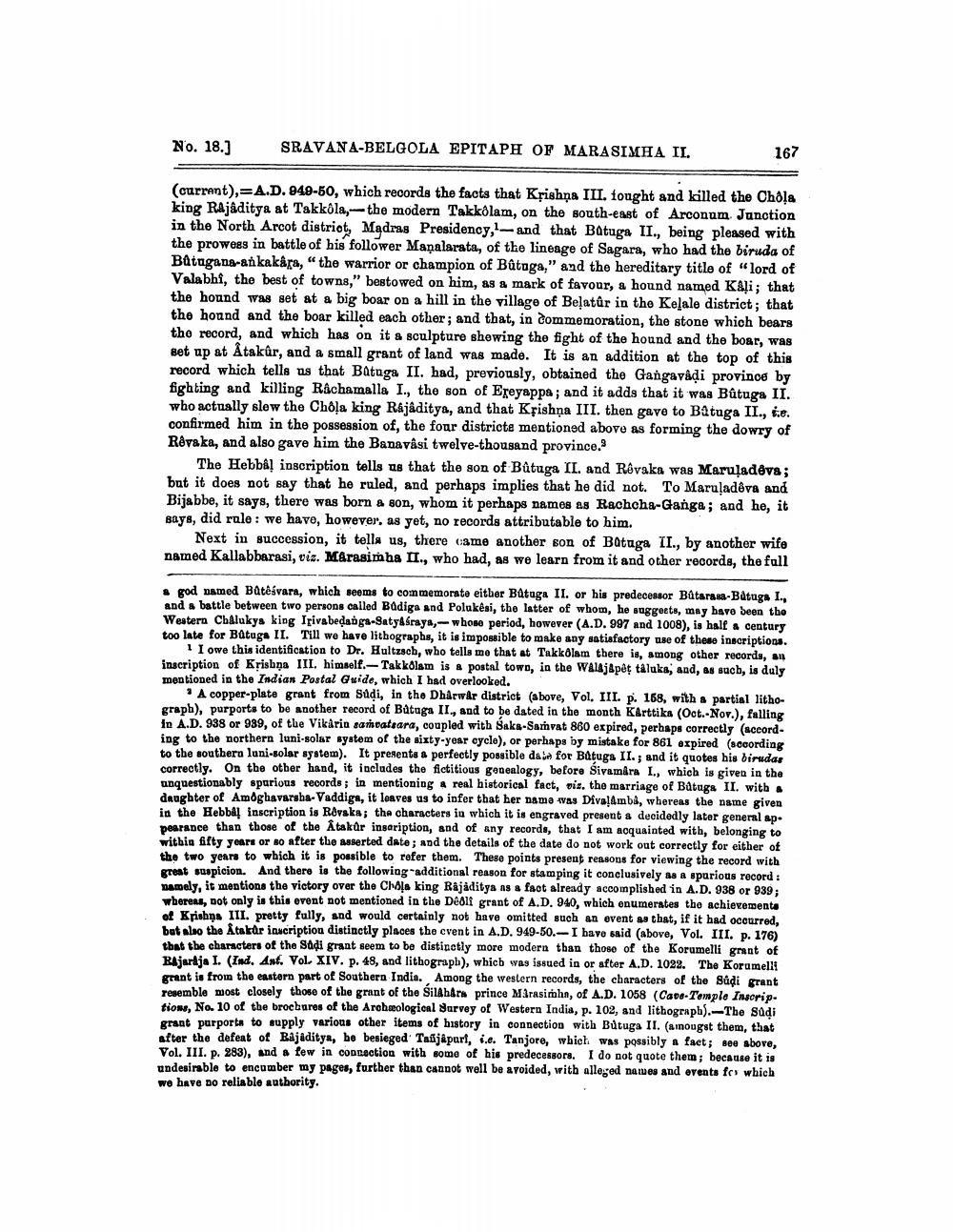________________
No. 18.)
SRAVANA-BELGOLA EPITAPH OF MARASIMHA IL.
167
(current),=A.D. 949-50, which records the facts that Kộishņa III. fought and killed the Chola king Rajâditya at Takkola,-the modern Takkôlam, on the south-east of Arconum Junction in the North Arcot district, Madras Presidency, and that Batuga II., being pleased with the prowess in battle of his follower Manalarata, of the lineage of Sagara, who had the biruda of Batugana-ankakara, “the warrior or champion of Bútoga," and the hereditary title of " lord of Valabhi, the best of towns," bestowed on him, as & mark of favour, a hound named Kaļi; that the hound was set at a big boar on a hill in the village of Belatur in the Kelale district; that the hound and the boar killed each other; and that, in commemoration, the stone which bears the record, and which has on it & sculpture shewing the fight of the hound and the boar, was set up at Atakûr, and a small grant of land was made. It is an addition at the top of this record which tells ns that Batuga II. had, previously, obtained the Gangavådi provincs by fighting and killing Rachamalla I., the son of Ereyappa ; and it adds that it was Bütuga II. who actually slew the Chôļa king Rájâditya, and that Kfishna III. then gave to Batuga II., ce. confirmed him in the possession of, the four districte mentioned above as forming the dowry of Rêvaka, and also gave him the Banayâsi twelve-thousand province.
The Hebbal inscription tells us that the son of Bûtuga II. and Rêvaka was Maruladeva; but it does not say that he ruled, and perhaps implies that he did not. To Maruladova aná Bijabbe, it says, there was born a son, whom it perhaps names as Rachcha-Ganga; and he, it says, did rule: we have, however, as yet, no records attributable to him.
Next in succession, it tells us, there came another son of Bataga II., by another wife named Kallabbarasi, viz. Merasimha II., who had, as we learn from it and other records, the full
. god named Batèsvara, which seems to commemorate either Bataga II. or his predecesor Båtaras-Båtuga I.. and a battle between two persons called Badiga and Polukesi, the latter of whom, he suggests, may have been the Western Chalukys king Irivabedanga-Satyasraya,- whose period, however (A.D. 997 and 1008), is half a century too late for Batuga II. Till we have lithographs, it is impossible to make any satisfactory use of these inscriptions.
1 I owe this identification to Dr. Hultzsch, who tells me that at Takkolam there is, among other records, an inscription of Krishna III. himself.-Takkolam is a postal town, in the WALAj&pet tåluka, and, as such, is duly mentioned in the Indian Postal Guide, which I had overlooked.
A copper-plate grant from Sudi, in the Dharwar district (above, Vol. IIL p. 168, with a partial lithograph), purports to be another record of Batuga II., and to be dated in the month Karttika (Oct.-Nov.), falling in A.D. 938 or 989, of the Vikärin samvatsara, coupled with Saks-Samvat 860 expired, perhaps correctly (according to the northern luni-solar system of the sixty-year cycle), or perhaps by mistake for 861 expired (sccording to the southera lani-solar system). It presents a perfectly possible dans for Batuga II. ; and it quotes his birudas correctly. On the other hand, it includes the fictitious gonealogy, before Sivamara I., which is given in the unquestionably spurious records; in mentioning & real historical fact, vis, the marriage of Batuga II. with daughter of Amoghavaraba-Vaddiga, it leaves us to infer that her name was Diva Amba, whereas the name given in the Hebbal inscription is Rovska; the characters in which it is engraved present a decidedly later general sp. pearance than those of the Atakar insaription, and of any records, that I am aoquainted with, belonging to withia fifty years or so after the deserted date; and the details of the date do not work out correctly for either of the two years to which it is possible to refer them. These points present reasons for viewing the record with great suspicion. And there is the following additional reason for stamping it conclusively spurious record :
amely, it mentions the victory over the Chas king Råjåditya as a fact already accomplished in A.D. 938 or 939: whereas, not only in this event not mentioned in the Debli grant of A.D. 940, which enumerates the achievements of Krishna III. pretty fully, and would certainly not have omitted such an event as that, if it had occurred, but also the Atakur inscription distinctly places the event in A.D. 949-50.- I have said above, Vol. III. p. 176) that the characters of the Sadi grant seem to be distinctiy more modern than those of the Korumelli grat of Bjarja L. (Ind. Ant. Vol. XIV. p. 48, and lithograph), whicb was issued in or after A.D. 1022. The Korumell! grant in from the eastern part of Southern India. Among the western records, the characters of the Sudi grant resemble most closely those of the grant of the Silahars prince Marasimhn, of A.D. 1058 (Cap-Temple Insorip. tions, No. 10 of the brochures of the Archeological Survey of Western India, p. 102, and lithograpb).-The Sudi grant purports to supply various other items of history in connection with Butuga II. (ainoogst them, that after the defeat of Bajaditya, bo besieged Taij&part, i.e. Tanjore, which was possibly a fact; see sbore, Vol. III. p. 283), and a few ja connection with some of his predecessors. I do not quote them; because it is undesirable to encomber my pagos, further than cannot well be avoided, with alloged names and events for which we have no reliable authority.




